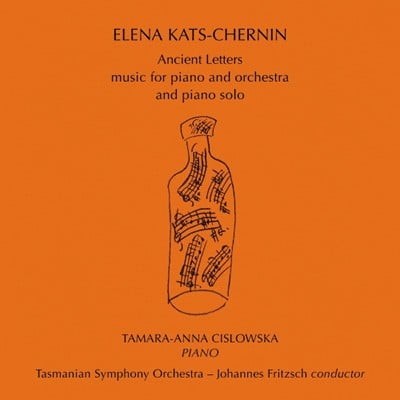2.2.2.2-4.2.3.1-timp.perc(1)-harp-strings(8.6.5.4.3)
Abbreviations (PDF)
Bote & Bock
In this work Elena Kats-Chernin contemplates the uncelebrated wife of one of her primary inspirations. Piano Concerto No.3 is called Lebewohl which means farewell in German. It’s an old fashioned term of endearment, literally ‘live well until we meet again’. Lebewohl explores the core and soul of Johann Sebastian Bach at the worst time of his life, the death of his first wife Maria. What are the ramifications of this tragedy? What does it do to Bach? Kats-Chernin honours the mysterious Maria with this work: the ‘forgotten’ wife of the baroque master about whom only cursory details are known.
Maria Barbara Bach lived for 36 years. In July 1720 her husband Johann Sebastian returned from a six week trip to find her dead and buried. Who broke the news to Johann Sebastian? Was it Maria’s sister? Was it his own six-year-old son Carl Philipp Emmanuel? Later Carl wrote of the awful shock that struck his father ‘he had left her hale and hearty on his departure. The news that she had been ill and died reached him only when he entered his own house’.
Imagine the scene for the thirty-five year old composer at the prime of his life and now suddenly, violently impelled to the edge of an abyss and plunged to his heart’s nadir.
Maria and Johann Sebastian had seven children together but lost three in infancy. It was thought that Maria’s unexplained final illness was a complication from childbirth. On that sickening summer day, Johann Sebastian arrived home to find himself the sole parent of four children between five and eleven, and without his wife of thirteen years.
How did this affect him? At what cost the psychological torment of losing Maria? Of being powerless to intercede in the most disastrous loss?
Did Johann Sebastian have a crisis of faith? Shake his fists in rage at his beloved God?
The five movements of the concerto roughly follow the stages of bereavement Johann likely experienced; shock and denial, pain and guilt, anger and bargaining, reflection and loneliness, acceptance and reconstruction. Each movement is prefaced by a quote from one of Bach’s Cantatas from the period.
I
the deep and bitter flood
though in midst of life we be,
snares of death surround us
save us, Lord, from sinking
In the deep and bitter flood.
— Martin Luther
Marked Agitato, this first movements centres around D, the same as Bach's Chaconne for solo violin, often recognised as an elegy for Maria Barbara. The piano is relentless throughout, punctuated with sharp chords featuring brass and percussion.
II
…behind night and clouds
how long, how long?
my anguish is too much
I can see no end at all
your sweet glance of grace
Is hidden behind night and clouds
the measure of tears
is always fully granted,
the wine of joy is lacking
and almost all my confidence has drained away
— Salomon Franck
The piano begins with a chorale in c-sharp minor, a tonality Bach often used to depict tragedy. A slow-moving string accompaniment enters as the piano chords gracefully double-back and retrace. A new idea emerges gently undulating over a descending baseline, echoing a passacaglia.
III
you thunderous word
O eternity you thunderous word,
O sword which bores through the soul,
O beginning without end!
O eternity, time beyond time,
I know not, facing great sorrow,
to where I can turn.
my fully dismayed heart shutters so
that my tongue is lodged between my gums.
— unknown, based on the hymn by Johann Rist
Clashes and manoeuvring between orchestra and soloist, something of a battle of wills and temperament. The piano writing becomes spiky: seventh and ninth intervals alternating with fragmented passage work and arpeggios broken apart. The emphasis is always slightly off centre.
IV
so aflame in love
though alas, there remains in my love
vast imperfection
my entire life hangs on to you.
Let me be so aflame in love
that I can love you eternally
with whole heart,
with whole soul, with all strength
and with whole mind
— Johann Oswald Knauer
A fragile piano line begins the movement, sustained and precarious, quoting Kats-Chernin’s piano piece ‘Eggshell’. High strings shadow the upper line and unembellished harmonies underpin the to and fro in the solo part. Woodwinds enter near the coda.
V
allow, princess, allow just one ray beam
allow, princess, allow just one ray
beam from Salem’s starry vaults.
and behold, with how great a downpour of tears
we enshrine your memorial.
In you, you exemplar of a great woman,
in you, you keeper of the faith,
this image of selflessness apparent.
one knows what one possesses from you,
posterity will not forget you
— Johann Christoph Gottsched
The piano tremolos ever-rising, always resisting the downward thrust of the orchestra which returns in another passacaglia-like theme reminiscent of the second movement; chanting and brassy. As the final climax is reached with the piano part in a vertical ascent of double octaves, Kats-Chernin reintroduces expanded material from movements one and two.
© Tamara-Anna Cislowska 2018
In the year 1720 something happened that changed the life of JS Bach forever. On returning from a trip to Karlsbad, he discovered that his wife of 12 years, Maria Barbara, had not only died during his absence but had been buried as well; all unbeknownst to him and during his absence. He was now a sole parent to their four remaining children. Lebewohl explores the circumstances, ramifications and regrets that shake his soul and faith to the core, leading to the eventual pouring of his heart into what would become his unrecognised elegy for his first love: the Chaconne. With words adapted from Martin Luther, JS Bach and other writings of the day, Elena Kats-Chernin delivers her third piano concerto as a series of contemplations on one of her primary inspirations and honours the ‘forgotten’ wife of the Baroque master.

Tamara-Anna Cislowska, piano / Tasmanian Symphony Orchestra / Johannes Fritzsch
ABC Classics (digital album)
